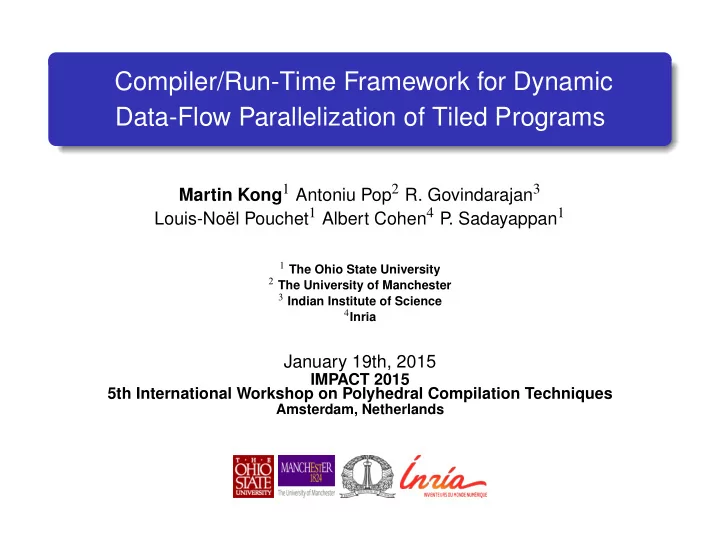

Compiler/Run-Time Framework for Dynamic Data-Flow Parallelization of Tiled Programs Martin Kong 1 Antoniu Pop 2 R. Govindarajan 3 Louis-Noël Pouchet 1 Albert Cohen 4 P . Sadayappan 1 1 The Ohio State University 2 The University of Manchester 3 Indian Institute of Science 4 Inria January 19th, 2015 IMPACT 2015 5th International Workshop on Polyhedral Compilation Techniques Amsterdam, Netherlands
Motivation: IMPACT’15 Motivating Example: Blur-Roberts Focus of this work: removal of data-parallel barriers executed on shared-memory multi-core machines 18 ¡ 16 ¡ 14 ¡ 12 ¡ ref-‑icc ¡ 10 ¡ GFLOPS/sec ¡ PLuTo ¡Minfuse ¡ 8 ¡ 6 ¡ PLuTo ¡Smar<use ¡ 4 ¡ Our ¡work ¡ 2 ¡ 0 ¡ ◮ Barrier involve global consensus opt-‑1 ¡ opt-‑8 ¡ opt-‑16 ¡ xeon-‑1 ¡ xeon-‑4 ¡ xeon-‑8 ¡ Processor-‑Cores ¡ ◮ Number of synchronizations depend upon: program structure and applied transformations Blur-Roberts kernel performance in GFLOPS/sec for AMD Opteron 6274 ◮ Some transformations could derive on (16 cores) and Intel Xeon E5-2650 (8 cores), on 1, half and all cores. loss of locality or parallelism OSU / UM / IISC / Inria 2
Motivation: IMPACT’15 Tiled Blur-Roberts Blur-Roberts tiled with PLuTo using the Smartfuse heuristic (fuse matching dimensions) Blur-Roberts tiled with PLuTo using the Minfuse heuristic (maximal decomposition) for (t1=0;t1<=floord(_PB_N-2,16);t1++) { lbp=max(0,ceild(32*t1-_PB_N+2,32)); ubp=min(floord(_PB_N-1,32),t1); #pragma omp parallel for private(lbv,ubv) if (_PB_N >= 3) { lbp=0; for (t2=lbp;t2<=ubp;t2++) { ubp=floord(_PB_N-2,32); if ((t1 == t2) && (t1 <= floord(_PB_N-2,32))) for (t4=max(1,32*t1);t4<=min(_PB_N-2,32*t1+31);t4++) #pragma omp parallel for private(lbv,ubv) B[1][t4] = (A[1][t4] + A[1][t4-1] + A[1][1+t4] + A[1+1][t4] + A[1 -1][t4] + A[1 -1][t4-1] + A[1 -1][t4+1] + A[1 +1][t4-1] + A[1 +1][t4+1])/8.0;; if (32*t2 == _PB_N-1) for (t2=lbp;t2<=ubp;t2++) for (t3=max(2,32*t1-_PB_N+1);t3<=32*t1-_PB_N+32;t3++) if ((_PB_N+31)%32 == 0) for (t3=0;t3<=floord(_PB_N-2,32);t3++) A[t3-1][_PB_N-2] = (B[t3-1][_PB_N-2]-B[t3-1 +1][_PB_N-2 -1]) + (B[t3-1 +1][_PB_N-2] - B[t3-1][_PB_N-2 -1]);; for (t4=max(1,32*t2);t4<=min(_PB_N-2,32*t2+31);t4++) { if ((_PB_N >= 5) && (_PB_N <= 32) && (t1 == 0) && (t2 == 0)) { for (t3=2;t3<=_PB_N-2;t3++) { lbv=max(1,32*t3); for (t4=1;t4<=2;t4++) { B[t3][t4] = (A[t3][t4] + A[t3][t4-1] + A[t3][1+t4] + A[1+t3][t4] + A[t3-1][t4] + A[t3-1][t4-1] + A[t3-1][t4+1] + A[t3+1][t4-1] + A[t3+1][t4+1])/8.0;; ubv=min(_PB_N-2,32*t3+31); } #pragma ivdep for (t4=3;t4<=_PB_N-2;t4++) { B[t3][t4] = (A[t3][t4] + A[t3][t4-1] + A[t3][1+t4] + A[1+t3][t4] + A[t3-1][t4] + A[t3-1][t4-1] + A[t3-1][t4+1] + A[t3+1][t4-1] + A[t3+1][t4+1])/8.0;; #pragma vector always A[t3-1][t4-1] = (B[t3-1][t4-1]-B[t3-1 +1][t4-1 -1]) + (B[t3-1 +1][t4-1] - B[t3-1][t4-1 -1]);; for (t7=lbv;t7<=ubv;t7++) } A[t3-1][_PB_N-2] = (B[t3-1][_PB_N-2]-B[t3-1 +1][_PB_N-2 -1]) + (B[t3-1 +1][_PB_N-2] - B[t3-1][_PB_N-2 -1]);; B[t4][t7] = (A[t4][t7] + A[t4][t7-1] + A[t4][1+t7] + A[1+t4][t7] + A[t4-1][t7] + } } A[t4-1][t7-1] + A[t4-1][t7+1] + A[t4+1][t7-1] + A[t4+1][t7+1])/8.0;; if ((_PB_N >= 33) && (t2 == 0)) { } for (t3=max(2,32*t1);t3<=min(_PB_N-2,32*t1+31);t3++) { for (t4=1;t4<=2;t4++) } B[t3][t4] = (A[t3][t4] + A[t3][t4-1] + A[t3][1+t4] + A[1+t3][t4] + A[t3-1][t4] + A[t3-1][t4-1] + A[t3-1][t4+1] + A[t3+1][t4-1] + A[t3+1][t4+1])/8.0;; for (t4=3;t4<=31;t4++) { if (_PB_N >= 4) { B[t3][t4] = (A[t3][t4] + A[t3][t4-1] + A[t3][1+t4] + A[1+t3][t4] + A[t3-1][t4] + A[t3-1][t4-1] + A[t3-1][t4+1] + A[t3+1][t4-1] + A[t3+1][t4+1])/8.0;; lbp=0; A[t3-1][t4-1] = (B[t3-1][t4-1]-B[t3-1 +1][t4-1 -1]) + (B[t3-1 +1][t4-1] - B[t3-1][t4-1 -1]);; } ubp=floord(_PB_N-3,32); } } #pragma omp parallel for private(lbv,ubv) if ((_PB_N == 4) && (t1 == 0) && (t2 == 0)) { for (t4=1;t4<=2;t4++) for (t2=lbp;t2<=ubp;t2++) B[2][t4] = (A[2][t4] + A[2][t4-1] + A[2][1+t4] + A[1+2][t4] + A[2 -1][t4] + A[2 -1][t4-1] + A[2 -1][t4+1] + A[2 +1][t4-1] + A[2 +1][t4+1])/8.0;; for (t3=0;t3<=floord(_PB_N-2,32);t3++) A[1][2] = (B[1][2]-B[1 +1][2 -1]) + (B[1 +1][2] - B[1][2 -1]);; } for (t4=max(1,32*t2);t4<=min(_PB_N-3,32*t2+31);t4++) { if ((t2 <= floord(_PB_N-2,32)) && (t2 >= ceild(_PB_N-32,32))) for (t3=max(2,32*t1-32*t2);t3<=min(min(_PB_N-2,32*t1-1),32*t1-32*t2+31);t3++) { lbv=max(2,32*t3); for (t4=32*t2;t4<=_PB_N-2;t4++) { B[t3][t4] = (A[t3][t4] + A[t3][t4-1] + A[t3][1+t4] + A[1+t3][t4] + A[t3-1][t4] + A[t3-1][t4-1] + A[t3-1][t4+1] + A[t3+1][t4-1] + A[t3+1][t4+1])/8.0;; ubv=min(_PB_N-2,32*t3+31); A[t3-1][t4-1] = (B[t3-1][t4-1]-B[t3-1 +1][t4-1 -1]) + (B[t3-1 +1][t4-1] - B[t3-1][t4-1 -1]);; #pragma ivdep } A[t3-1][_PB_N-2] = (B[t3-1][_PB_N-2]-B[t3-1 +1][_PB_N-2 -1]) + (B[t3-1 +1][_PB_N-2] - B[t3-1][_PB_N-2 -1]);; #pragma vector always } for (t7=lbv;t7<=ubv;t7++) if (t2 <= floord(_PB_N-33,32)) for (t3=max(2,32*t1-32*t2);t3<=min(min(_PB_N-2,32*t1-1),32*t1-32*t2+31);t3++) A[t4][t7] = (B[t4][t7]-B[t4+1][t7-1]) + (B[t4+1][t7] - B[t4][t7-1]);; for (t4=32*t2;t4<=32*t2+31;t4++) { B[t3][t4] = (A[t3][t4] + A[t3][t4-1] + A[t3][1+t4] + A[1+t3][t4] + A[t3-1][t4] + A[t3-1][t4-1] + A[t3-1][t4+1] + A[t3+1][t4-1] + A[t3+1][t4+1])/8.0;; } A[t3-1][t4-1] = (B[t3-1][t4-1]-B[t3-1 +1][t4-1 -1]) + (B[t3-1 +1][t4-1] - B[t3-1][t4-1 -1]);; } } } } Good parallelism, good vectorization! } Bad locality! Good locality! Two barriers "Bad" parallelism, poor vectorization! One barrier executed O ( n ) times! OSU / UM / IISC / Inria 3
Motivation: IMPACT’15 Our solution ● Prune duplicated tile ● Project schedule onto dependences selected tile dimensions ● Prune non-forward tile ● Decompose ● Compute tile domains ● Tile to coarsen granularity dependences ● Compute tile dependences Extract tile-level Compute PRDG Apply PluTo tiling polyhedral from tile-level algorithm abstractions abstractions Generate code with Build task graph Partition tile-level point-to-point from decorated domains by synchronization PRDG and collect dependence from task graph input/output signatures info dependence info ● Keep partitions separated ● Expand PRDG nodes to ● Prune covering ● Replicate internal structures accommodate partitions dependences ● Generate stream declarations ● Remap PRDG edges ● Prune by transitive ● Pragmatization (clause according to the reduction generation from dependence dependences signatures ● Compute stream sizes signature) OSU / UM / IISC / Inria 4
Recommend
More recommend